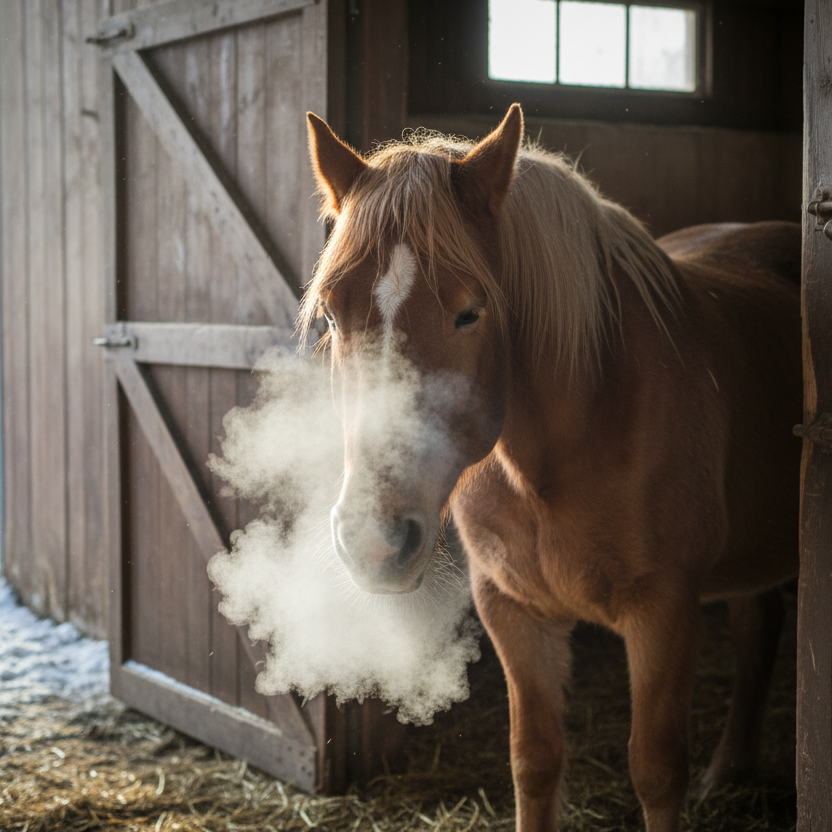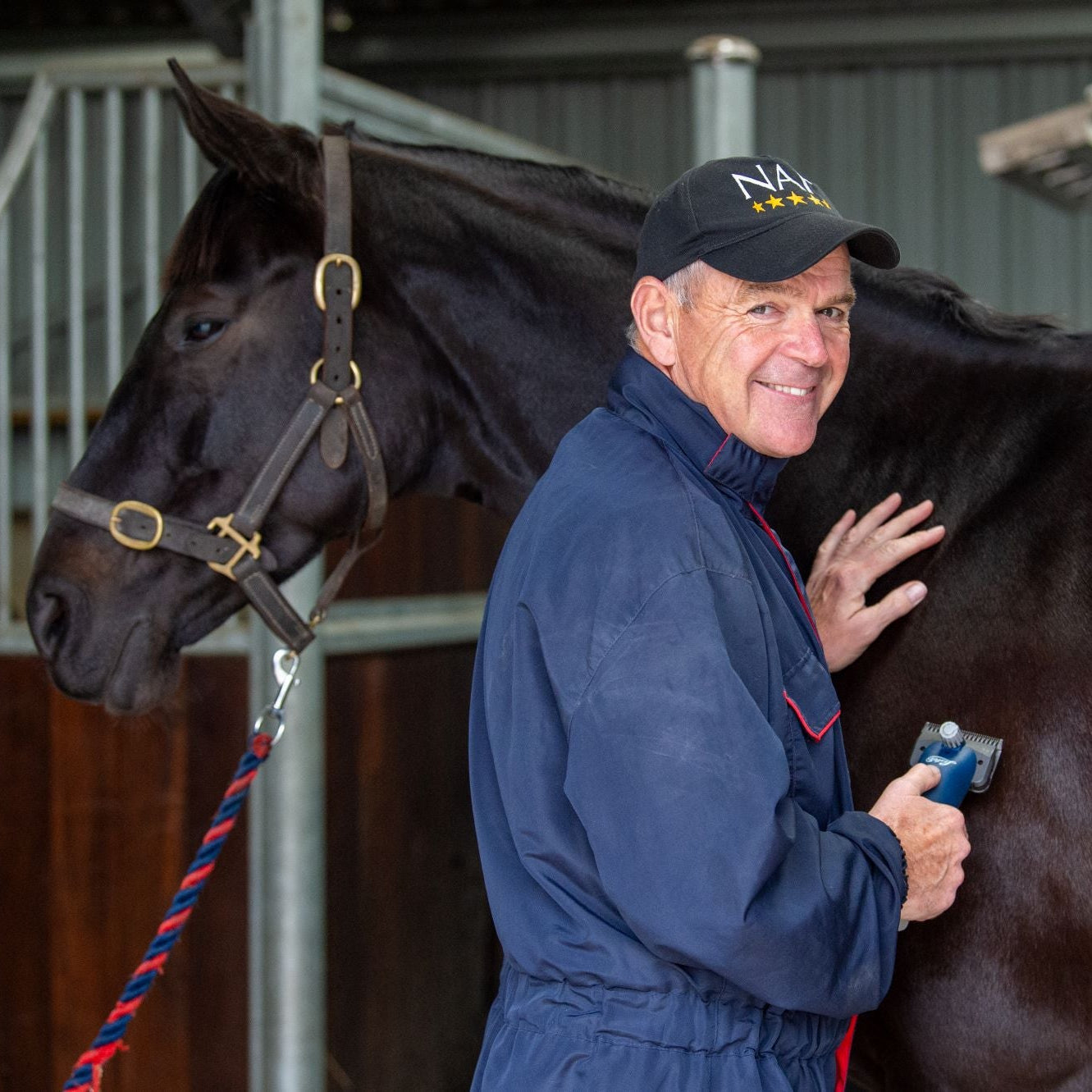Seasonal Changes and Their Impact on Respiratory Health
Your horse’s lungs are amazing. Large, powerful and naturally evolved for powering maximum performance, they are a big part of what makes our horses naturally athletic. Unfortunately, they also have an Achilles heel – tiny particles such dust, mould and allergens, can be really debilitating. Horses’ respiratory tracts are sensitive to any small particulate challenge, and the risk is often increased over winter.
Stabling full or part-time through the worst of the weather is often a practical choice for us owners, and can benefit horses too in terms of protection from the cold. However, spending longer indoors increases the risk of respiratory issues such as Equine Asthma and general irritation caused by dust, ammonia and poor ventilation.
So, what can we, as horse owners, do to reduce the risk?
Stable design and ventilation
Proper airflow is paramount in winter stables which should be designed to allow for natural ventilation while protecting horses from drafts. Good ventilation doesn’t mean bitter cold air blasting through the stable; it means ensuring fresh air can enter and stale, ammonia-laden air can exit. Windows, vents, and doors should be positioned to create cross-ventilation without creating direct drafts on horses. Ridge vents and louvered windows are excellent ways to allow warm air to rise and escape while bringing in fresh air from lower down.
A stable with poor ventilation will trap dust, mould spores, and ammonia, which can irritate the respiratory tract over time. Aim for air that is constantly moving, without chilling, to minimize the buildup of airborne irritants. Monitoring your horse for signs of coughing, nasal discharge, or increased respiratory rate can alert you early to ventilation issues.
Choose low-dust bedding
Bedding is another critical factor in respiratory health. Horses inhale fine particles from straw, shavings, and other bedding materials, which can exacerbate airway inflammation.
Choosing low-dust bedding is crucial. Wood shavings, when well-prepared and dust-extracted, are generally safer than straw for horses prone to respiratory issues. Pelleted bedding, peat, hemp, or paper-based products can also be good alternatives.
Though, if competing, be aware that hemp is a risk of a positive FEI dope test for CBD (Cannabidiol) or CBDA (Cannabidiolic acid), and so is best avoided.
When bedding your horse, consider both comfort and cleanliness. Avoid over-bedding in an attempt to make the stall warmer; deep bedding can retain moisture and ammonia if not managed properly, increasing the risk of respiratory irritation. Regular mucking out of urine-soaked bedding and prompt removal of wet patches is essential.
Bedding management
There are arguments on both sides for deep litter or shallow bedding and, to a large extent, it will come down to your preference for what you can manage well, and what works for your horse.
Deep litter, where bedding is added on top of decomposing material, can provide insulation for horses in cold climates. However, deep litter systems must be carefully managed to prevent ammonia accumulation.
If done correctly, with frequent removal of wet material and careful monitoring of litter depth deep litter can be safe and comfortable. For horses with sensitive lungs, shallower, frequently changed bedding may be safer because it reduces the chance of ammonia build-up and dust proliferation.
Some owners will choose to bank bedding and shavings around the walls to provide additional insulation. While this can help keep horses warmer, it can also increase the risk of respiratory irritation if that bedding is not dry and clean. Banking up can trap moisture and create pockets where ammonia accumulates, which can exacerbate airway problems. Either commit to turning and checking those banks as part of your daily care, or focus on overall ventilation and warmth through stable construction and appropriate rugging, rather than relying on bedding as insulation.
Traditionally banking was also used to lessen the risk of a horse getting cast, or stuck, against the walls if they lay down or rolled awkwardly. In truth, there is little evidence that banking is effective as prevention, and far better to ensure a suitable stable size is used to allow the horse to have plenty of room to move and lie down safely. Veterinary tips for safe and effective stable banking
Choose low dust forage
Preserved forage is central to a healthy winter diet, but either hay or haylage can be a respiratory risk, and care is taken in managing them safely. If soaking hay, a short soak of around 10-15 minutes is sufficient to reduce dust without compromising nutrition.
Ensure you drain and feed the hay whilst still wet, as it if allowed dry the dust will return. Ensure you use fresh water each time, and dispose appropriately. For haylage it is important that it has been produced and stored correctly, with no damage to wrap and no evidence of mould or excessive heat in the bale.
Read our guide to soaking hay safely and effectively for your horse
Targeted nutrition
Research shows that supporting your horse with supplementary antioxidants can support a healthy respiratory tract, helping to manage those facing respiratory stress. Vitamin C, well-known for our own respiratory health, can also support a strong, clear respiratory tract in horses. Additionally, naturally sourced antioxidants can play an important role, alongside traditional herbal approaches, such as echinacea and unique herbal blends for optimising respiratory health.
If possible, feed from the floor to aid natural drainage.
Temperature management without compromising air quality
Maintaining warmth in the stable should be a consideration, but don’t make the mistake of simply closing doors and windows, which can drastically reduce airflow. Extra warmth should never come at the expense of ventilation. Remember, horses have a much wider TNZ (Thermal Neutral Zone) than humans, meaning the temperature range in which they are happy and comfortable without having to expend energy to stay warm or cool down. Horses tolerate cool well if they are dry, fed adequately, and have access to shelter and clean bedding.
TNZ for humans - comfort zone is between 15 - 27 Degrees C meaning we feel colder or hotter above and below these temperatures. Where for horses their comfort zone is between 0-25 degrees. So even when we are feeling a little chilly our horses are most likely in their comfort zone!
Routine Maintenance and Monitoring
Routine stable maintenance is key to preventing respiratory problems. Daily mucking out, regular removal of cobwebs, and ensuring that feed and bedding are free from mould and dust will dramatically reduce airborne irritants. Daily cleaning feed and water buckets and ensuring adequate hydration is also important because dry air can exacerbate respiratory issues.
Additionally, monitoring your horse’s behaviour and respiratory signs is crucial. Persistent coughing, nasal discharge, or reduced performance in winter should trigger a review of stable management practices. Sometimes, even subtle changes in bedding type, stable layout, or ventilation can dramatically improve respiratory health.
Tips for a Healthy Winter Stable
- Use low-dust bedding avoiding excessively deep litter unless carefully managed
- Use low-dust forage, or short soak hay
- Maintain consistent, gentle airflow; aim for cross-ventilation without drafts
- Keep bedding dry and muck out regularly to prevent ammonia build-up
- Move your horse out of the stable when mucking out and filling forage feeders
- Avoid banking up bedding unless carefully managed
- Ensure feed, forage and water are clean, mould-free, and dust-free
- Remember their lower TNZ.
- Turnout as much as possible, for that breath of fresh air
And finally – don’t forget yourself!
Research shows, unsurprisingly, that activities such as mucking out and filling haynets can all represent a real dust risk for ourselves. Consider wearing a good quality face mask for your daily stable management, as it isn’t just your horse’s respiratory health that is important.
Conclusion
Winter stabling need not mean compromised respiratory health. By considering good stable design, ventilation, feed and bedding management, you can create a comfortable, healthy environment for you and your horse. With careful planning and attention to detail, your horses can stay comfortable and breathe easily all winter long.
Selected References
- Brown A.E, Twigg-Flesner A. Are we over-rugging? A preliminary research article into how rugging affects clipped, stabled horses using the Orscana© rug-monitoring device. 2018. 8th Alltech-Hartpury Student Conference.
- https://www.horseandhound.co.uk/news/wont-stop-horses-getting-cast-vets-warning-bedding-banks-674012
- Kirschvink N, Fiévez L, Bougnet V, Art T, Degand G, Smith N, Marlin D, Roberts C, Harris P, Lekeux P. Effect of nutritional antioxidant supplementation on systemic and pulmonary antioxidant status, airway inflammation and lung function in heaves-affected horses. Equine Vet J. 2002 Nov;34(7):705-12
- Pearson W, Charch A, Brewer D, Clarke AF. Pilot study investigating the ability of an herbal composite to alleviate clinical signs of respiratory dysfunction in horses with recurrent airway obstruction. Can J Vet Res. 2007 Apr;71(2):145-51.
- Perrin M.A Effects of the air quality in equine stable environments on the respiratory health and allergy health and allergy response of human personnel: A Review. Honors Theses and Capstones. 582. https://scholars.unh.edu/honors/582
Written by: Kate Hore, Head Nutritionist. RNutr (Animal), R.Anim.Technol (Cert), BSc(Hons). – Find out more about Kate and out Technical Team HERE.


